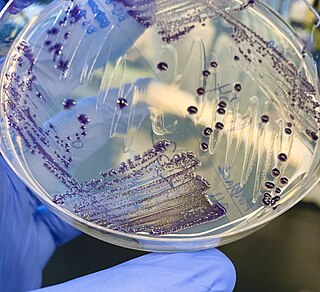
Chitinases are hydrolytic enzymes that break down glycosidic bonds in chitin. They catalyse the following reaction:

Mycoremediation is a form of bioremediation in which fungi-based remediation methods are used to decontaminate the environment. Fungi have been proven to be a cheap, effective and environmentally sound way for removing a wide array of contaminants from damaged environments or wastewater. These contaminants include heavy metals, organic pollutants, textile dyes, leather tanning chemicals and wastewater, petroleum fuels, polycyclic aromatic hydrocarbons, pharmaceuticals and personal care products, pesticides and herbicides in land, fresh water, and marine environments.
Dehalococcoides is a genus of bacteria within class Dehalococcoidia that obtain energy via the oxidation of hydrogen and subsequent reductive dehalogenation of halogenated organic compounds in a mode of anaerobic respiration called organohalide respiration. They are well known for their great potential to remediate halogenated ethenes and aromatics. They are the only bacteria known to transform highly chlorinated dioxins, PCBs. In addition, they are the only known bacteria to transform tetrachloroethene to ethene.
Candex is a dietary supplement manufactured by Pure Essence Laboratories. It is marketed as an enzymatic remedy to treat the yeast infection candida. Having the status of a dietary supplement, its efficiency has not been proven in scientifically controlled and peer-reviewed trials. Similar formulas exist, such as Candigest.

Stenotrophomonas is a genus of Gram-negative bacteria, comprising at least ten species. The main reservoirs of Stenotrophomonas are soil and plants. Stenotrophomonas species range from common soil organisms to opportunistic human pathogens ; the molecular taxonomy of the genus is still somewhat unclear.
Delftia is a genus of Gram-negative bacteria that was first isolated from soil in Delft, Netherlands. The species is named after both the city, and in honor of pioneering research in the field of bacteriology that occurred in Delft. Cells in the genus Delftia are rod shaped and straight or slightly curved. Cells occur singly or in pairs, are 0.4–0.8ɥM wide and 2.5–4.1 μm long. Delftia species are motile by flagella, nonsporulating, and chemo-organotrophic.
Delftia acidovorans is a Gram-negative, motile, non-sporulating, rod-shaped bacterium known for its ability to biomineralize gold and bioremediation characteristics. It was first isolated from soil in Delft, Netherlands. The bacterium was originally categorized as Pseudomonas acidovorans and Comamonas acidovorans before being reclassified as Delftia acidovorans.
Lysinibacillus sphaericus is a Gram-positive, mesophilic, rod-shaped bacterium commonly found on soil. It can form resistant endospores that are tolerant to high temperatures, chemicals and ultraviolet light and can remain viable for long periods of time. It is of particular interest to the World Health Organization due to the larvicide effect of some strains against two mosquito genera, more effective than Bacillus thuringiensis, frequently used as a biological pest control. L. sphaericus cells in a vegetative state are also effective against Aedes aegypti larvae, an important vector of yellow fever and dengue viruses.

Phanerochaete is a genus of crust fungi in the family Phanerochaetaceae.
In enzymology, a manganese peroxidase (EC 1.11.1.13) is an enzyme that catalyzes the chemical reaction
Cupriavidus metallidurans is a non-spore-forming, Gram-negative bacterium which is adapted to survive several forms of heavy metal stress.

The genus Massilia belongs to the family Oxalobacteriaceae, and describes a group of gram-negative, motile, rod-shaped cells. They may contain either peritrichous or polar flagella. This genus was first described in 1998, after the type species, Massilia timonae, was isolated from the blood of an immunocompromised patient. The genus was named after the old Greek and Roman name for the city of Marseille, France, where the organism was first isolated. The Massilia genus is a diverse group that resides in many different environments, has many heterotrophic means of gathering energy, and is commonly found in association with plants.
Delftia tsuruhatensis is a Gram-negative, rod-shaped, catalase- and oxidase-positive, motile bacterium from the Comamonadaceae family. It was first isolated from a wastewater treatment plant in Japan in 2003. D. tsuruhatensis is an opportunistic and emergent pathogen. All documented human infections are healthcare-associated.

Extracellular enzymes or exoenzymes are synthesized inside the cell and then secreted outside the cell, where their function is to break down complex macromolecules into smaller units to be taken up by the cell for growth and assimilation. These enzymes degrade complex organic matter such as cellulose and hemicellulose into simple sugars that enzyme-producing organisms use as a source of carbon, energy, and nutrients. Grouped as hydrolases, lyases, oxidoreductases and transferases, these extracellular enzymes control soil enzyme activity through efficient degradation of biopolymers.
Geobacter metallireducens is a gram-negative metal-reducing proteobacterium. It is a strict anaerobe that oxidizes several short-chain fatty acids, alcohols, and monoaromatic compounds with Fe(III) as the sole electron acceptor. It can also use uranium for its growth and convert U(VI) to U(IV).
Cycloclasticus pugetii is a species of bacterium found in marine sediments. It is notable for being able to break down aromatic hydrocarbon, including naphthalene, phenanthrene, anthracene and toluene. It is an aerobic, gram-negative, rod-shaped bacterium from the family Piscirickettsiaceae, and it is motile by means of single polar flagellum. Strain PS-1 is its type strain. It was named in honor of Peter Puget.
Leptospirillum ferriphilum is an iron-oxidising bacterium able to exist in environments of high acidity, high iron concentrations, and moderate to moderately high temperatures. It is one of the species responsible for the generation of acid mine drainage and the principal microbe used in industrial biohydrometallurgy processes to extract metals.
Bacillus gaemokensis is a bacterium. It is a Gram-positive, rod-shaped, endospore-forming organism with the type strain BL3-6T.
Glutamicibacter soli is a species of gram-positive bacteria.
Delftia deserti is a Gram-negative, short rod-shaped, motile bacterium from the genus Delftia, which has been isolated from desert soil in Turpan in China. D. deserti is of the Betaproteobacteria lineage within the Comamonadaceae family.





